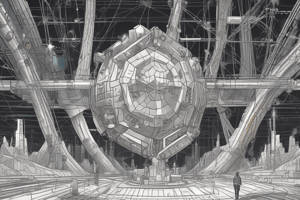Podcast
Questions and Answers
What is the primary characteristic of a one component system?
What is the primary characteristic of a one component system?
- It can display multiple phases depending on external conditions.
- It is homogeneous in nature. (correct)
- It always has a varying composition.
- It consists of multiple substances.
What does the Gibbs phase rule equation indicate for a one component system?
What does the Gibbs phase rule equation indicate for a one component system?
- F = P - C + 2
- F = 2 - P
- F = 3 - P (correct)
- F = C - P + 1
Which of the following is an example of a two component system?
Which of the following is an example of a two component system?
- Liquid mercury (Hg)
- A diamond structure
- Pure oxygen (O₂)
- A mixture of salt (NaCl) and water (H₂O) (correct)
In a two component system, what type of solution follows Raoult's and Dalton's law?
In a two component system, what type of solution follows Raoult's and Dalton's law?
What unique phenomena can occur in a two component system that does not typically occur in one component systems?
What unique phenomena can occur in a two component system that does not typically occur in one component systems?
What is the primary defining feature of a single-component system?
What is the primary defining feature of a single-component system?
In a two-component system, which factor can significantly influence the system's properties?
In a two-component system, which factor can significantly influence the system's properties?
Which of the following best describes the phase diagrams of two-component systems?
Which of the following best describes the phase diagrams of two-component systems?
What does the term 'miscible' refer to in the context of two-component systems?
What does the term 'miscible' refer to in the context of two-component systems?
Which equation is essential for understanding the phase equilibria in a single-component system?
Which equation is essential for understanding the phase equilibria in a single-component system?
In which way is the phase behavior of single-component systems simpler compared to two-component systems?
In which way is the phase behavior of single-component systems simpler compared to two-component systems?
What is a common model used to describe the behavior of two-component systems?
What is a common model used to describe the behavior of two-component systems?
Which of the following statements is true regarding two-component systems that exhibit non-ideal behavior?
Which of the following statements is true regarding two-component systems that exhibit non-ideal behavior?
Study Notes
One Component System
- Definition: A system consisting of a single substance or phase.
- Characteristics:
- Homogeneous in nature (uniform composition).
- Example: Pure water, where only H₂O molecules are present.
- Properties:
- The properties of the system can be described using state variables like temperature, pressure, and volume.
- Phase changes (e.g., melting, boiling) only involve transitions between different states of one substance.
- Thermodynamics:
- Governed by the Gibbs phase rule: F = C - P + 2 (where F is degrees of freedom, C is the number of components, P is the number of phases).
- For a single component system (C=1), F = 3 - P.
Two Component System
- Definition: A system composed of two distinct substances or phases.
- Characteristics:
- Can exhibit varying interactions between the two components.
- Example: A mixture of salt (NaCl) and water (H₂O).
- Properties:
- The system can display multiple phases depending on composition, temperature, and pressure.
- Phase diagrams are often used to represent the equilibrium between phases (solid, liquid, gas).
- Thermodynamics:
- Governed by the Gibbs phase rule: F = C - P + 2 (where C = 2 for two component system).
- Greater complexity in behavior compared to one component systems.
- Possible to have azeotropes (constant boiling mixtures), congruent melting points, and other phenomena unique to mixtures.
- Types of Two Component Systems:
- Ideal Solutions: Components follow Raoult's and Dalton's law.
- Non-Ideal Solutions: Deviations from ideal behavior due to strong interactions (e.g., dipole-dipole, hydrogen bonding).
- Binary Phase Diagrams: Graphical representation showing phase behavior based on temperature and composition.
One Component System
- A single substance or phase
- Homogeneous with uniform composition
- Example: Pure water (only H₂O molecules)
- Properties described by state variables (temperature, pressure, volume)
- Phase changes involve transitions between states of the same substance
- Governed by Gibbs phase rule: F = C - P + 2 (F = degrees of freedom, C = components, P = phases)
- Single component system (C = 1): F = 3 - P
Two Component System
- Two distinct substances or phases
- Varying interactions between components
- Example: Salt (NaCl) and water (H₂O) mixture
- Multiple phases depending on composition, temperature, and pressure
- Phase diagrams represent phase equilibrium (solid, liquid, gas)
- Gibbs phase rule applies: F = C - P + 2 (C = 2 for two components)
- More complex behavior than one component systems
- Azeotropes (constant boiling mixtures), congruent melting points, and other mixture phenomena possible
- Types:
- Ideal Solutions: Follow Raoult's and Dalton's law
- Non-Ideal Solutions: Deviations from ideal behavior due to strong interactions (e.g., dipole-dipole, hydrogen bonding)
- Binary Phase Diagrams: Graphical representation of phase behavior based on temperature and composition
One Component System
- A system with a single chemical substance
- Examples: Pure water (H2O), nitrogen (N2), or oxygen (O2)
- Can exist in solid, liquid, or gas phases
- Phase transitions are controlled by temperature and pressure
- Phase Diagrams: Graphical representations showing the relationship between phases at varying temperature and pressure
- Water's phase diagram includes solid (ice), liquid (water), and gas (steam) phases
Two Component System
- Mixture of two distinct chemical species
- Examples: Saltwater (NaCl + H2O) or air (N2 + O2)
- Interactions between components can change properties
- Exhibits a range of phase behaviors
Single-Component Systems
- Consist of a single pure substance
- Composition remains constant
- Thermodynamic Properties: Determined by temperature, pressure, and volume
- Phase Equilibria: Governed by Gibbs phase rule (P + F = C + 2)
- P: Number of phases
- F: Degrees of freedom
- C: Number of components
Two-Component Systems
- Composed of two components, allowing for mixtures
- Composition can vary
- Phase Diagrams: Show regions of single-phase and two-phase coexistence
- Ideal solution model and Raoult's law (for vapor pressures) are common models
- Interaction Effects:
- Non-ideal behavior due to strong interactions like hydrogen bonding
- Activity coefficients are used to understand deviations from ideality
- Types:
- Miscible: Components mix uniformly (e.g., alcohol + water)
- Immiscible: Components do not mix (e.g., oil + water)
Differences Between One and Two Component Systems
- Complexity: Two-component systems are more complex due to interactions between components
- Phase Behavior: Single-component systems have simpler phase behavior compared to two-component systems
- Thermodynamics: Single-component systems focus on state variables, while two-component systems consider interactions and mixture behavior.
Studying That Suits You
Use AI to generate personalized quizzes and flashcards to suit your learning preferences.
Description
Explore the fundamentals of one-component and two-component systems in thermodynamics. Understand their definitions, characteristics, and properties, along with the implications of the Gibbs phase rule. This quiz will help you grasp essential concepts for studying phase systems.




